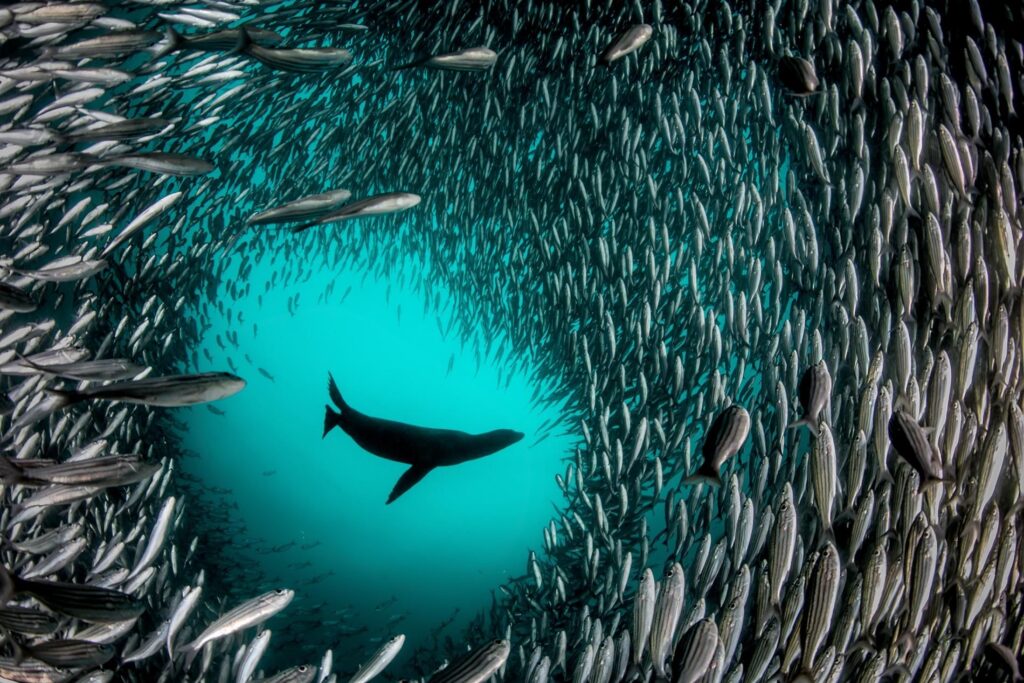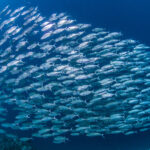Fish are among the most well-adapted animals to life in the water. Over millions of years, they have evolved a range of specialized features that help them survive, thrive, and reproduce in aquatic environments. These adaptations are critical for feeding, movement, reproduction, and avoiding predators in diverse underwater ecosystems—from shallow coral reefs to the deepest parts of the ocean. In this article, we will explore how fish adapt to life underwater, focusing on their anatomical, behavioral, and physiological features.
1. Streamlined Bodies for Efficient Movement
One of the key adaptations of fish is their streamlined body shape, designed to reduce water resistance and allow for efficient movement through water.
- Hydrodynamic Shape: Fish typically have a tapered, fusiform body (narrow at both ends and wide in the middle), which helps them glide smoothly through the water. This shape minimizes drag, making it easier for fish to swim quickly and efficiently.
- Fins and Tails: Fish are equipped with various fins that help with balance, direction, and propulsion. The caudal fin (tail fin) is the primary means of propulsion, providing the thrust needed for movement. The pectoral and pelvic fins help stabilize the fish, while the dorsal and anal fins help with steering.
These features make fish highly efficient swimmers, capable of moving long distances to find food or escape predators.
2. Gills for Breathing Underwater
Unlike land animals, fish breathe oxygen that is dissolved in water. This is made possible by their gills, specialized respiratory organs that extract oxygen from water and expel carbon dioxide.
- Gill Filaments: The gills are made up of thin filaments that are covered in tiny, hair-like structures called cilia. These filaments have a large surface area and are surrounded by tiny blood vessels, allowing for efficient gas exchange.
- Countercurrent Exchange: Fish gills operate on a system called countercurrent exchange, where water flows in the opposite direction to the flow of blood. This maximizes oxygen absorption and helps fish extract as much oxygen as possible from the water, even when it is low in oxygen content.
This adaptation allows fish to thrive in a variety of aquatic environments, from oxygen-rich surface waters to low-oxygen deep-sea habitats.
3. Sensory Adaptations for Navigating and Hunting
Fish have developed a variety of sensory adaptations that help them navigate their underwater world, locate food, and avoid predators.
- Lateral Line System: The lateral line is a sensory system found in many fish that detects vibrations and changes in water pressure. This system helps fish sense nearby movements, such as approaching predators or schools of prey, even in murky or dark water. It’s like a sixth sense that helps fish stay aware of their surroundings.
- Electroreception: Some fish, such as sharks, rays, and certain species of fish, have electroreception abilities. They can detect weak electrical fields produced by other animals, which is especially helpful in the dark depths of the ocean or in turbid waters. This ability is crucial for hunting prey, particularly those that may be hidden or buried in the sand.
- Color Vision and Camouflage: Many fish can see in color, which helps them detect food and communicate with one another. Additionally, some species have evolved camouflage to blend into their surroundings, providing protection from predators. Fish can change their skin color or pattern through specialized cells called chromatophores to blend in with coral, rocks, or the sea floor.
4. Buoyancy Control with Swim Bladders
Fish need to maintain neutral buoyancy to avoid sinking or floating uncontrollably in the water. Most fish achieve this with the help of a swim bladder, an internal gas-filled organ that allows them to regulate their position in the water column.
- Gas Exchange: The swim bladder works by adjusting the amount of gas inside the organ. By increasing or decreasing the gas volume, fish can rise or sink without expending energy. This adaptation helps fish maintain a stable position in the water and conserve energy during swimming.
- Adaptations for Different Depths: Some fish, like deep-sea species, have specialized swim bladders that can withstand high pressure, while others, such as bottom-dwelling species, may lack swim bladders altogether. Fish that live at great depths often have large, flexible bladders that allow them to survive in extreme conditions.
5. Thermoregulation and Adaptation to Temperature
Temperature plays a significant role in the life of fish, and different species have evolved unique ways of coping with varying water temperatures.
- Cold-Blooded Nature: Fish are generally ectothermic (cold-blooded), meaning their body temperature is regulated by the temperature of the water around them. However, certain species have developed adaptations to cope with extreme temperatures. For example, fish living in colder waters have antifreeze proteins in their blood to prevent ice formation.
- Heat Sensitivity and Migration: Some fish, like tuna, are capable of regulating their body temperature in certain parts of their bodies (e.g., their brain and muscles) to maintain optimal performance. This adaptation allows them to live in varying water temperatures and even migrate long distances between warm and cold waters.
6. Feeding Adaptations for Underwater Hunting
Fish have evolved an impressive array of feeding strategies to meet their nutritional needs in the underwater environment.
- Specialized Mouths and Teeth: Fish exhibit a wide variety of mouth shapes and tooth structures depending on their diet. Predatory fish, such as sharks and barracudas, have sharp, pointed teeth for grasping and tearing prey. Herbivorous fish, like parrotfish, have flat, grinding teeth for scraping algae off rocks and coral.
- Filter Feeding: Some fish, like baleen whales or certain species of manta rays, are filter feeders, using specialized structures to filter plankton and small organisms from the water. They have comb-like structures or specialized gill rakers to trap food as water flows through their mouths.
- Ambush Predation and Speed: Certain species, such as lionfish or groupers, are ambush predators, waiting patiently for prey to come near before quickly striking. Others, like tuna and marlins, rely on speed and endurance to chase down and capture fast-moving prey.
7. Reproductive Adaptations
Fish have developed a variety of strategies for reproduction to ensure the survival of their species in the underwater environment.
- External Fertilization: Most fish lay eggs in the water, where fertilization occurs externally. Many fish species lay hundreds or thousands of eggs at once to increase the chances of survival. For example, salmon swim upstream to their spawning grounds, where they release eggs and sperm into the water to fertilize them.
- Internal Fertilization: Some species, like sharks and rays, use internal fertilization, where the male transfers sperm directly into the female. In these species, offspring are often born alive and fully developed, providing them with a higher chance of survival in the competitive ocean environment.
- Parental Care: While most fish rely on spawning in large numbers to ensure survival, some species, such as seahorses and some cichlids, provide parental care. Male seahorses carry fertilized eggs in a special brood pouch, where they protect and care for the developing young.

Conclusion
Fish are incredible survivors and have developed a wide range of physical, behavioral, and physiological adaptations to thrive underwater. Whether it’s their streamlined bodies, gills for breathing, sensory abilities, or buoyancy control, each adaptation plays a critical role in their ability to navigate, feed, and reproduce in the aquatic world. These adaptations have allowed fish to occupy almost every habitat on Earth, from shallow coastal waters to the deep ocean, ensuring their continued success in the diverse and often challenging underwater environments they inhabit.



